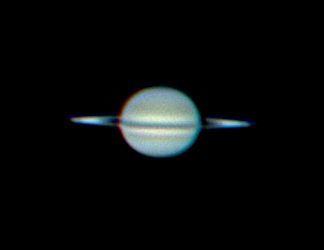

These images cover the 2009/10 season. Saturn reaches opposition on 25th March 2009.
The rings closed completely back in September, but Saturn was on the far side of the Sun at the time. This means that we are now beginning to see the northern side of the rings. They will slowly continue to open until early January after which they will close again reaching a minimum in June. The rings will slowly open year by year until 2017 when we will see the northern side at their maximum.
The images are in chronological order, so the best may well be in the middle.
 |
And here with four of its satellites. Move your mouse over the image to see which is which. Dione is rather faint so, on the mouseover image, I have edited a single pixel to make its position clear. These are composite images, I have substituted a correctly-exposed image of the planet over the over-exposed image that was necessary to show the satellites. |
 |
By early March, Saturn was rising early enough to be accessible late in the evening rather than in the early morning. Here it was still an hour or so short of its highest but at 37° altitude and 158° azimuth (right over my local town). Saturn was 1,280 million kilometres (8.56 AU) away and subtended an angle of 19 arc-seconds. This image was taken at 10 frames per second. I do not usually use this speed as the camera compresses the data more (and therefore degrades the image more) than it does at 5 fps. I then picked out this image as the best I had for that evening without noticing that it was the 10 fps one. So the extra compression does not seem to have degraded the image more than was compensated for by being able to throw away more bad frames and still have a suitable number to stack. Date and Time: 5th March 2010 00:17 UT Camera: ToUcam 840K Telescope: LX200 with X2 lens Capture: K3CCDTools. Low gamma, high saturation, 1/25", 65% gain, 2414 frames (@ 10 fps) Processing: Registax. 219 frames stacked, histogram 0-145, wavelets 1 = 10, 2 = 5. |
 |
Only three days later but the skies were exceptionally clear, not that that seems to have yielded a spectacularly clearer image I also waited a little longer so that Saturn was at its maximum altitude (39° at azimuth 183°). Saturn was still 1,280 million kilometres (8.56 AU) away and subtended an angle of 19 arc-seconds. I have enhanced this image rather more than I usually do, but I'm not sure it has improved the image very much. Date and Time: 8th March 2010 01:23 UT Camera: ToUcam 840K Telescope: LX200 with X2 lens Capture: K3CCDTools. Low gamma, high saturation, 1/25", 35% gain, 1583 frames Processing: Registax. 171 frames stacked, wavelets 1-3 = 10, histogram 0-140. |